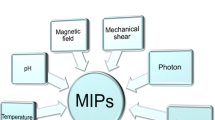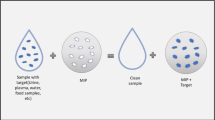Abstract
Molecularly imprinted polymeric membranes have been emerged since 1990. Among various kinds of molecular imprinting studies, the application of molecular imprinting to membrane separation is still a novel investigation. In the present review paper, molecularly imprinted polymeric membranes are summarized and examined. The application of molecular imprinting to membrane separation shortly leads to high performance separation membranes.
Similar content being viewed by others
References
Arshady R & Mosbach K (1981) Synthesis of substrate-selective polymers by host-guest polymerization. Makromol. Chem. 182: 687-692.
Bender ML & Komiyama M (1978) Cyclodextrin Chemistry. Springer, New York. Cram DJ (1988) The design of molecular hosts, guests, and their complexes. Angew. Chem. Int. Ed. Engl. 27: 1009-1020.
Diederich F (1988) Complexation of neutral molecules by cyclophane hosts. Angew. Chem. Int. Ed. Engl. 27: 362-386.
Hong J-M, Anderson PE, Qian J & Martin R (1998) Selectivelypermeable ultrathin film composite membranes based on molecularly-imprinted polymers. Chem. Mater. 10: 1029-1033.
Ikeda A & Shinkai S (1997) Novel cavity using calix[n]arene skeltones: Toward molecular recognition and metal binding.
Kobayashi T, Wang HY & Fujii N (1995) Molecular imprinting of theophylline in acrylonitrile-acrylic acid copolymer membrane. Chem. Lett. 927-928.
Kobayashi T, Wang HY & Fujii N (1998) Molecular imprint membranes of polyacrylonitrile copolymers with different acrylic acid segments. Anal. Chim. Acta 365: 81-88.
Kondo Y & Yoshikawa M (2001) Effect of solvent composition on chiral recognition ability of molecularly imprinted DIDE derivatives. Analyst 126: 781-783.
Kondo Y, Yoshikawa, M & Okushita H (2000) Molecularly imprinted polyamide membranes for chiral recognition. Polym. Bull. 44: 517-524.
Lehn JM (1988) Supramolecular chemistry-Scope and perspectives Molecules, supermolecules, and molecular devices. Angew. Chem. Int. Ed. Engl. 27: 89-112.
Marx-Tibbon A & Willner I (1994) Photostimulated imprinted polymers: a light-regulated medium for transport of amino acids. J. Chem. Soc., Chem. Commun. 1261-1262.
Mathew-Klotz J & Shea J (1996) Imprinted polymer membranes for the selective transport of targeted neutral molecules. J. Am. Chem. Soc. 118: 8154-8155.
Mosbach K & Ramström O (1996) The emerging technique of molecular imprinting and its future impact on biotechnology. Bio/Technology 14: 163-170.
Mulder M (1996) Basic Principles of Membrane Technology. Kluwer Academic Publishers, Dordrecht.
Nowick JS, Chen JS & Noronha G (1993) Molecular recognition in micelles: The roles of hydrogen bonding and hydrophobicity in adenine-thymine base-pairing in SDS micelles. J. Am. Chem. Soc. 115: 7636-7644.
Ohya Y, Miyaoka J & Ouchi T (1996) Recruitment of enzyme activity in albumin by molecular imprinting. Macromol. Rapid Commun. 17: 871-874.
Pedersen CJ (1988) The discovery of crown ethers. Angew. Chem. Int. Ed. Engl. 27: 1021-1027.
Piletsky SA, Dubei IY, Fedroyak DM & Kukhar VP (1990) Substrate-selective polymeric membranes. Selective transfer of nucleic acid components. Biopolym. Kletka 6: 55-58.
Piletsky SA, Panasyuk TL, Piletskaya EV, Nicholls IA & Ulbricht M(1999) Receptor and transport properties of imprinted polymer membranes-a review. J. Membr. Sci. 157: 263-278.
Piletsky SA, Matuschewski H, Schedler U, Wilpert A, Piletska EV, Thiele TA & Ulbricht M (2000) Surface functionalization of porous polypropylene membranes with molecularly imprinted polymers by photograft copolymerization in water. Macromolecules 33: 3092-3098.
Rebek J Jr. (1990a) Molecular recognition with model systems. Angew. Chem. Int. Ed. Engl. 29: 245-255.
Rebek J Jr. (1990b) Model Studies inmolecular recognition. Science 235: 1478-1484.
Reddy PS, Kobayashi T & Fujii N (1999) Molecular imprinting in hydrogen bonding networks on polyamide nylon for recognition of amino acids. Chem. Lett. 293-294.
Sasaki DY, Kurihara K & Kunitake T (1991) Specific, multiplepoint binding of ATP and AMP to a guanidium-functionalized monolayer. J. Am. Chem. Soc. 113: 9685-9686.
Sellergren B (1997) Imprinted polymers: stable, reusable antibodymimics for highly selective separations. Am. Lab. 14: 163-167.
Sellergren B & Andersson L (1990) Molecular recognition in macroporous polymers prepared by a substrate analogue imprinting strategy. J. Org. Chem. 55: 3381-3383.
Shea KJ & Dougherty TK (1986) Molecular recognition on synthetic amorphous surfaces. The influence of functional group positioning on the effectiveness of molecular recognition. J. Am. Chem. Soc. 108: 1091-1093.
Shimidzu T & Yoshikawa M (1983a) Photo-induced carrier mediated transport of alkali metal salts. J. Membr. Sci. 13: 1-13
Shimidzu T & Yoshikawa M (1983b) Photocontrols of alkali metal salt permeation with 1-octadecyl-3,3-dimethyl-6_-nitrospiro(indoline-2,2_-2H-benzopyran)-blended membrane. Polym. J. 15: 631-634.
Stahl M, Mansson M-T & Mosbach K (1990) The synthesis of a D-amino acid ester in an organic media with α-chymotrypsin modified by a bio-imprinting procedure. Biotechnol. Lett. 12: 161-166.
Tone S, Masawaki T & Eguchi K (1996) The optical resolution of amino acids by plasma polymerized terpene membranes. J. Membr. Sci. 118: 31-40.
Wang HY, Kobayashi T & Fujii N. (1996) Molecular imprint membranes prepared by the phase inversion precipitation technique. Langmuir 12: 4850-4856.
Wang HY, Kobayashi T & Fujii N (1997a) Surface molecular imprinting on photosensitive dithiocarbamoyl polyacrylonitrile membranes using photograft polymerization. J. Chem. Tech. Biotecnol. 70: 355-362.
Wang HY, Kobayashi T, Fukuya T & Fujii N (1997b) Molecular imprint membranes prepared by the phase inversion precipitation technique. 2. Influence of coagulation temperature in the phase inversion process on the encoding in polymeric membranes. Langmuir 13: 5396-5400.
Wulff G (1982) Selective binding to polymers via covalent bonds. The construction of chiral cavities as specific receptor sites. Pure Appl. Chem. 54: 2093-2102.
Wulff G (1995) Molecular imprinting in cross-linked materials with the aid of molecular templates-a way towards artificial antibodies. Angew. Chem. Int. Ed. Engl. 34: 1812-1832.
Wulff G & Sarhan A (1972) The use of polymers with enzymeanalogous structures for the resolution of racemates. Angew. Chem. Int. Ed. Engl. 11: 341 (Angew. Chem. 84: 364).
Wulff G, Sarhan A & Zabrocki K (1973) Enzyme-analogue polymers and their use for the resolution of racemates. Tetrahedron Lett. 44: 4329-4332.
Wulff G, Poll H-G & Minarik M (1986) Enzyme-analogue built polymers. XIX Racemic resolution on polymers containing chiral cavities. J. Liq. Chromatogr. 9: 385-405.
Yoshikawa M, Ogata N & Shimidzu T (1986) Polymer membrane as a reaction field. III. Effect of membrane polarity on selective separation of a water-ethanol mixture through synthetic polymer membranes. J. Membr. Sci. 26: 107-113.
Yoshikawa M, Izumi J, Kitao T, Koya S & Sakamoto S (1994) Membranes for enantioselective separation: synthesis and characterization. Preprints for the 16th Annual Meeting of the Membrane Society of Japan: A1-1-1.
Yoshikawa M, Izumi J, Kitao T & Sakamoto S (1996) Molecularly imprinted polymeric membranes containing DIDE derivatives for optical resolution of amino acids. Macromolecules 29: 8197-8203.
Yoshikawa M, Izumi J & Kitao T (1997a) Enantioselecyive electrodialysis of amino acids with charged polar side chains through molecularly imprinted polymeric membranes containing DIDE derivatives. Polym. J. 29: 205-210.
Yoshikawa M, Izumi J, Kitao T & Sakamoto S (1997b) Alternative molecularly imprinted polymeric membranes from a tetrapeptide residue consisting of D-or L-amino acids. Macromol. Rapid Commun. 18: 761-767.
YoshikawaM(1998a)Molecularly imprinted polymeric membranes for optical resolution. In: Bartsch RA & Maeda M (eds.) Molecular and Ionic Recognition with Imprinted Polymers. ACS Symposium Ser. 703 (pp. 170-187). ACS, Washington, DC.
Yoshikawa M, Izumi, J, Ooi T, Kitao T, Guiver MD & Robertson GP (1998b) Carboxylated polysulfone membranes having a chiral recognition site induced by an alternative molecular imprinting technique. Polym. Bull. 40: 517-524.
YoshikawaM, Izumi, J & Kitao T (1999a) Alternative molecular imprinting, a facile way to introduce chiral recognition sites. React. Funct. Polym. 42: 93-102.
Yoshikawa M, Ooi T & Izumi J (1999b) Alternative molecularly imprinted membranes from a derivative of natural polymer, cellulose acetate. J. Appl. Polym. Sci. 72: 493-499.
Author information
Authors and Affiliations
Rights and permissions
About this article
Cite this article
Yoshikawa, M. Molecularly imprinted polymeric membranes. Bioseparation 10, 277–286 (2001). https://doi.org/10.1023/A:1021537602663
Issue Date:
DOI: https://doi.org/10.1023/A:1021537602663




